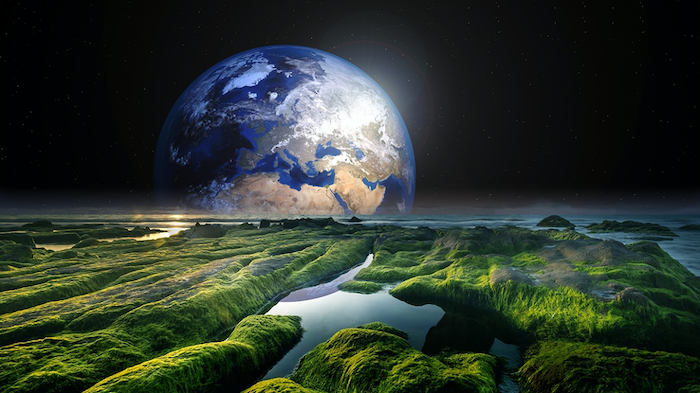 Earth & Space
Earth & Space
Are planets with oxygen-rich atmospheres rare?
Oxygen is a life-sustaining element that makes up about twenty percent of the air we breathe. Our research suggests that the stepwise rise of O2 in our atmosphere is easily explainable through simple chemical reactions, suggesting that breathable atmospheres may be relatively commonplace.

Complex life on Earth requires oxygen. Understanding how oxygen levels have evolved on our planet can provide an insight into our own evolution and the possibility of complex life evolving elsewhere. Current theories suggest that Earth's O2 levels have risen three times over its 4.5 billion year history. The first "Great Oxidation Event" occurred roughly 2.4 billion years ago, and established oxygen as a major element of the atmosphere. The second and third oxygenation events occurred at around 800 and 400 million years ago, when atmospheric oxygen finally rose to present day levels and the whole ocean became oxygen-rich.
The increasing levels of oxygen have been tentatively linked to two main causes: the impactful evolution of life and changes in tectonics. For example, as plants, marine algae and bacteria live, they release oxygen while producing food in a process called photosynthesis. Therefore, as plant life expanded, the oxygen levels could have increased in the atmosphere and ocean. Alternatively, tectonic shifts could provide more or less material for oxygen to react with, altering the rate at which oxygen is removed from the atmosphere.
Despite our understanding of these basic processes, nobody has been able to build a model where all of the oxygenation events happen at the right times. This suggests that the high-oxygen world we enjoy today is a consequence of very unlikely events, which may be extremely rare elsewhere in the galaxy. The aim of our project was to tackle this problem and create a model that explains how the oxygen level reached its present day value.
While creating our model, we considered two crucial variables; the cycling of phosphorus and the early ocean-based photosynthetic bacteria. Phosphorus is a key "limiting nutrient" for the photosynthetic bacteria - it is available only in small concentrations in the ocean and controls how much photosynthesis can occur on long timescales. Therefore, the more phosphorus the more oxygen is produced. But phosphorus has a more complex relationship with oxygen - when the oxygen level in the ocean rises, phosphorus tends to be largely removed, slowing photosynthesis back down. Consequently, the oxygen level stabilizes. In the long run though, limited photosynthesis restricts the food available for the other, non-photosynthetic organisms. As they starve, they use up less oxygen that they normally need to burn their food just like humans do. The result is that the oxygen level in the ocean increases dramatically again.
So the behavior of phosphorus in the ocean can lead to rapid changes in the oxygen levels. But can it explain how oxygen reached today's level over the Earth's history? We think that it can. When we combined the gradual reduction in tectonic activity due to the cooling of Earth's interior alongside the phosphorus-oxygen dynamics in our model, we observed three unique oxygenation events in the atmosphere and oceans, just like the ones that have been identified in Earth's geological record.
Based on these findings, the path to a habitable oxygenated world could be relatively simple. As photosynthetic bacteria evolved, they started to produce the oxygen in the oceans, followed by the inevitable cooling down of the inner Earth, which pushed the oxygen level up as less oxygen was consumed by the volcanic gases. But instead of a simple rise over time, the peculiar behavior of phosphorus led to the stepped increases in the atmospheric and ocean oxygen levels that occurred on Earth. So overall, finding a breathable atmosphere on an alien world may be much more likely to find than we used to think in the past.
Original Article:
Alcott L, Mills B, Poulton S. Stepwise Earth oxygenation is an inherent property of global biogeochemical cycling. Science. 2019;366(6471):1333-1337.Next read: Exposing the remnant core of a giant planet by David Armstrong
Edited by:
Dr. Monika Stankova , Senior Scientific Editor
We thought you might like
An exoplanet surrounded by an atmosphere larger than its star
Nov 26, 2015 in Earth & Space | 4 min read by Vincent BourrierAn exoplanet with glowing water reveals its nature
May 24, 2018 in Earth & Space | 3.5 min read by Tom EvansGaseous heavy metals in the atmosphere of an ultra-hot exoplanet
May 14, 2019 in Earth & Space | 4 min read by Jens HoeijmakersClimatic Changes for Earths in Sun-like Stellar Binaries
Jun 29, 2020 in Earth & Space | 3.5 min read by Billy QuarlesMore from Earth & Space
Discovery of the first radiation belt beyond the Solar System
Jan 27, 2025 in Earth & Space | 3.5 min read by Juan Bautista Climent OliverOne million (paper) satellites
Jan 24, 2025 in Earth & Space | 3 min read by Ewan Wright , Andrew FalleVolcanic Ash: A Nutrient Boost for Reef-Building Corals
Sep 18, 2024 in Earth & Space | 4 min read by Frank Förster , Tom SheldrakeAmmonia Energy: A Call for Environmental Awareness
Aug 29, 2024 in Earth & Space | 3.5 min read by Matteo Bertagni , Robert Socolow , Amilcare PorporatoLikely increase in coral thermal tolerance at a Pacific archipelago
Dec 29, 2023 in Earth & Space | 3 min read by Liam LachsEditor's picks
Trending now
Popular topics


